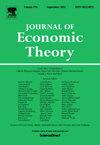Minimal contagious sets: Degree distributional bounds
IF 1.2
3区 经济学
Q3 ECONOMICS
引用次数: 0
Abstract
Agents in a network adopt an innovation if a certain fraction of their neighbors has already done so. We study the minimal contagious set size required for a successful innovation adoption by the entire population, and provide upper and lower bounds on it. Since detailed information about the network structure is often unavailable, we study bounds that depend only on the degree distribution of the network – a simple statistic of the network topology. Moreover, as our bounds are robust to small changes in the degree distribution, they also apply to large networks for which the degree distribution can only be approximated. Applying our bounds to growing networks shows that the minimal contagious set size is linear in the number of nodes. Consequently, for outside of knife-edge cases (such as the star-shaped network), contagion cannot be achieved without seeding a significant fraction of the population. This finding highlights the resilience of networks and demonstrates a high penetration cost in the corresponding markets.
最小传染集:度分布界
如果网络中的代理有一定比例的邻居已经这样做了,那么它们就会采用一种创新。我们研究了整个群体成功采用创新所需的最小传染集大小,并给出了它的上限和下限。由于网络结构的详细信息通常是不可用的,我们研究仅依赖于网络度分布的边界-网络拓扑的简单统计。此外,由于我们的边界对度分布的微小变化具有鲁棒性,因此它们也适用于度分布只能近似的大型网络。将我们的边界应用于不断增长的网络表明,最小传染集大小在节点数量上是线性的。因此,对于边缘病例(如星形网络)之外的情况,如果不播种相当一部分人口,就无法实现传染。这一发现突出了网络的弹性,并证明了相应市场的高渗透成本。
本文章由计算机程序翻译,如有差异,请以英文原文为准。
求助全文
约1分钟内获得全文
求助全文
来源期刊

Journal of Economic Theory
ECONOMICS-
CiteScore
2.50
自引率
12.50%
发文量
135
期刊介绍:
The Journal of Economic Theory publishes original research on economic theory and emphasizes the theoretical analysis of economic models, including the study of related mathematical techniques. JET is the leading journal in economic theory. It is also one of nine core journals in all of economics. Among these journals, the Journal of Economic Theory ranks fourth in impact-adjusted citations.
 求助内容:
求助内容: 应助结果提醒方式:
应助结果提醒方式:


